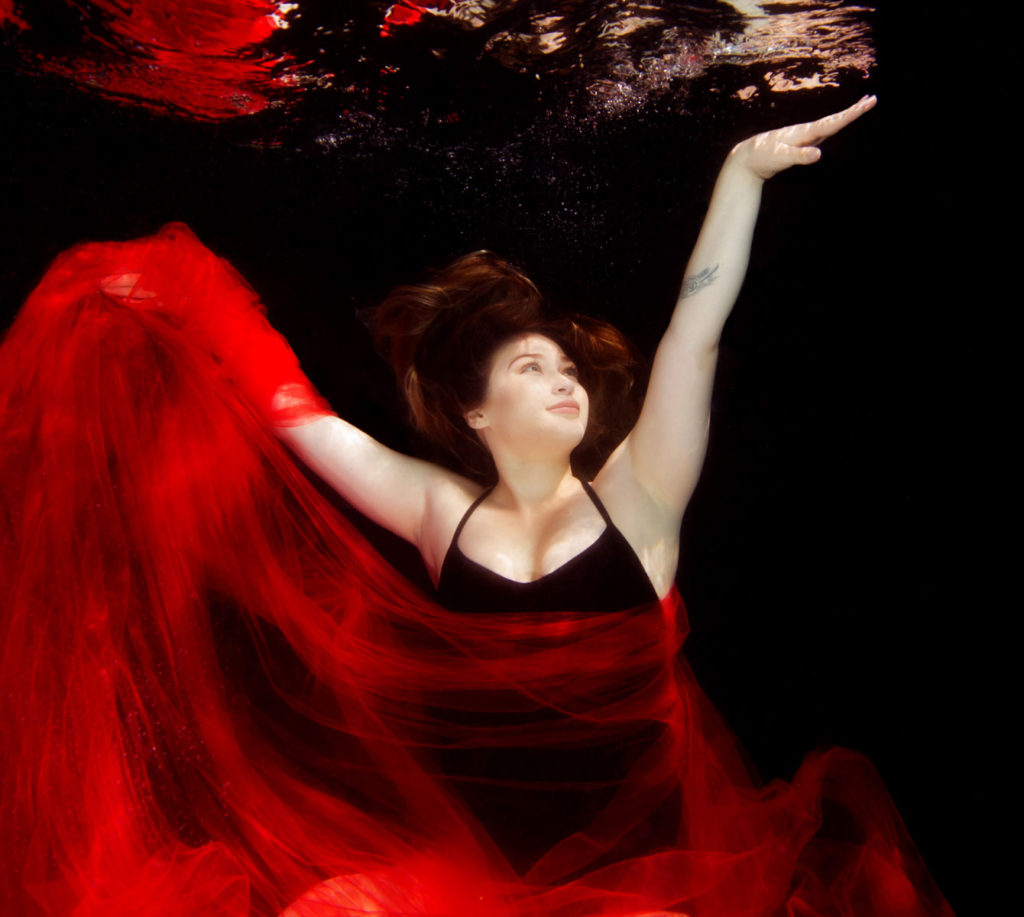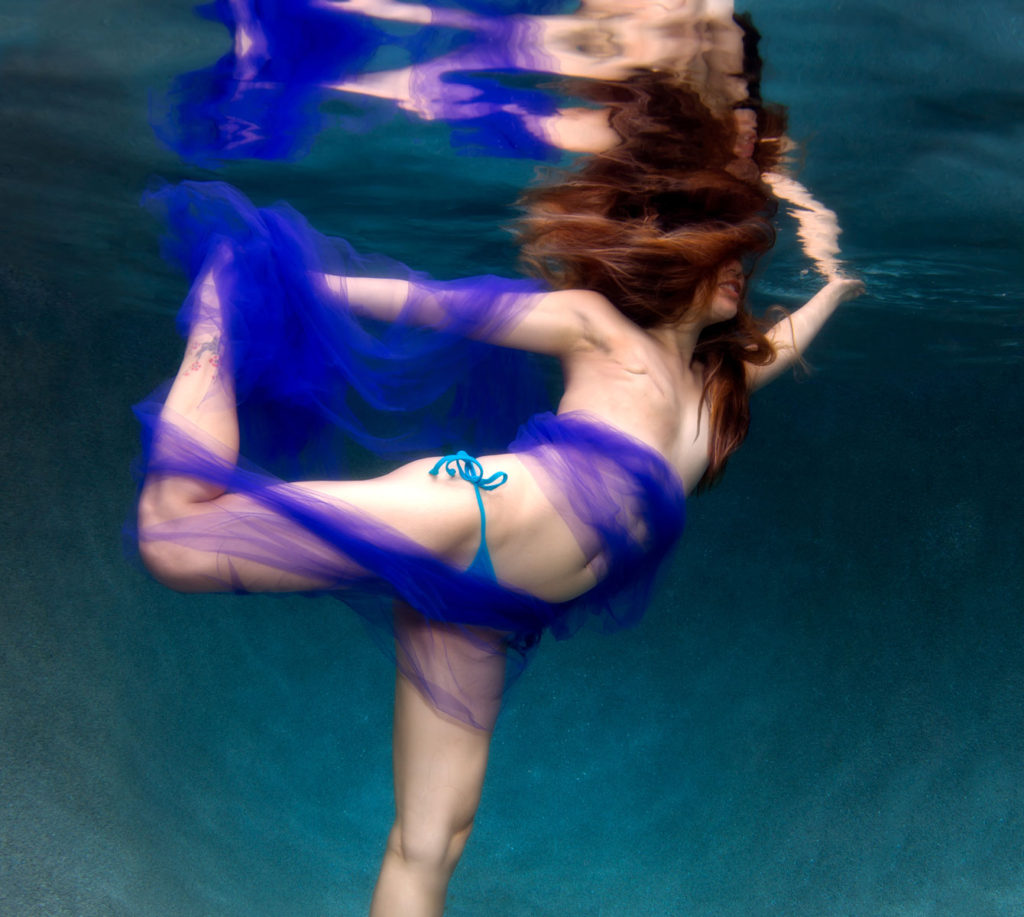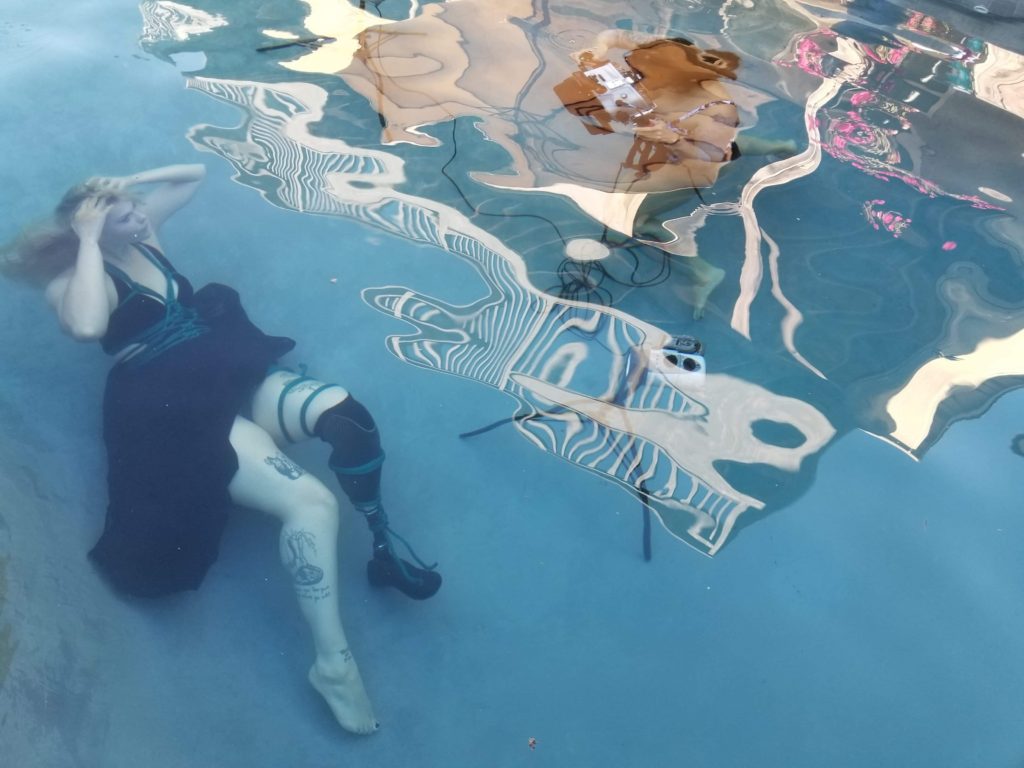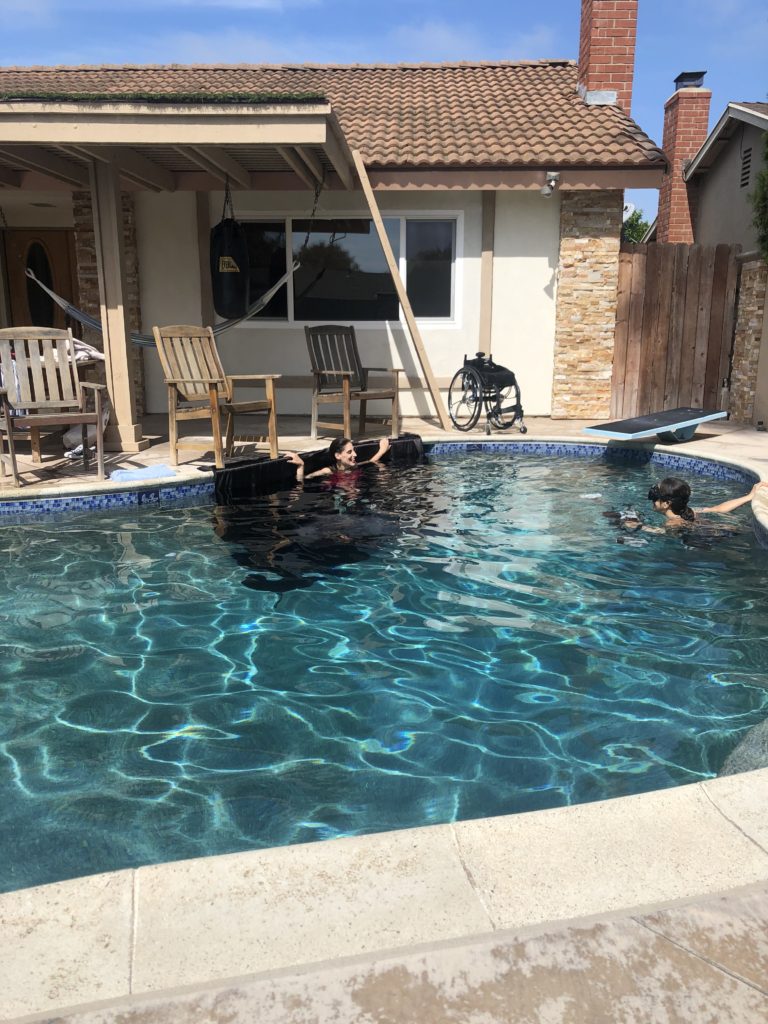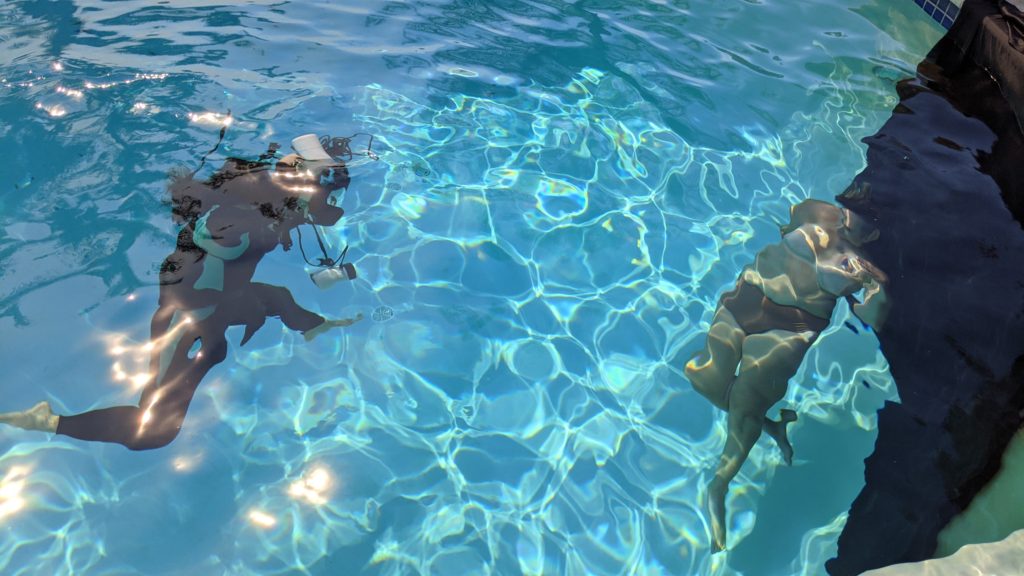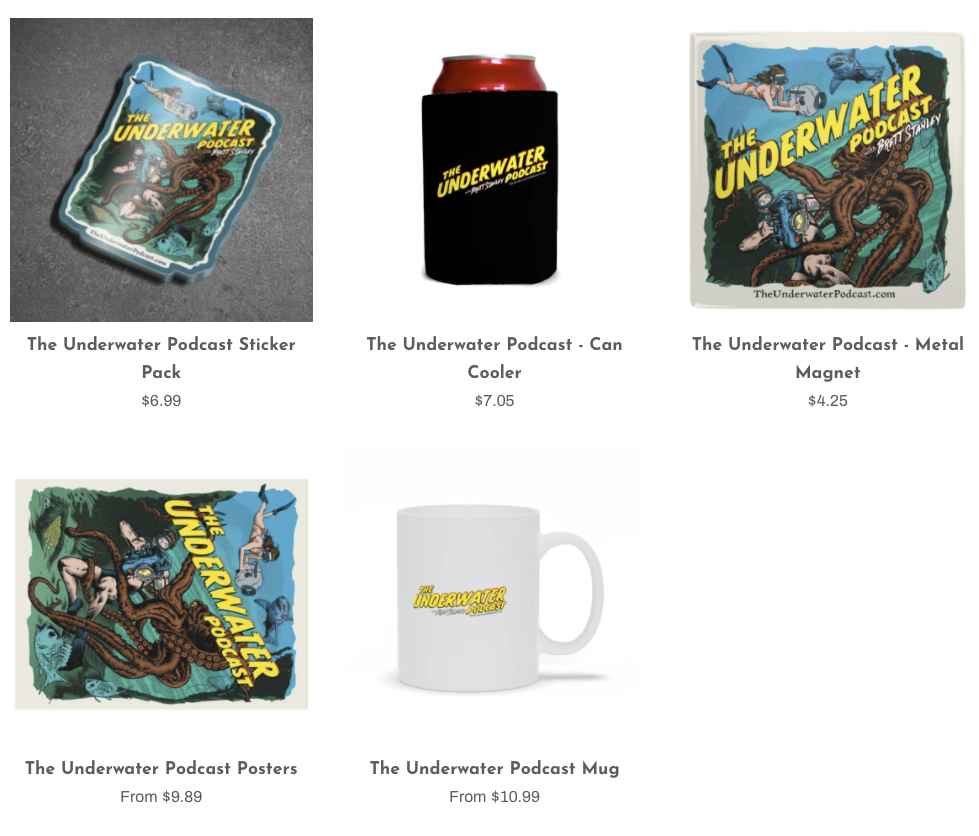Portrait Photographer Erena Shimoda
In episode twenty nine we’re honoring Breast Cancer Awareness month with underwater photographer Erena Shimoda.
Erena works with cancer and trauma survivors to give them an experience like no other, and a way to help them heal emotionally through the therapeutic immersion. Erena raised money to fund her work, donating almost half of it to charity and the rest to photograph 13 cancer survivors.
We talk about her approach to this work, and how her own trauma helps her guide others through the process.
Follow this guest: Website, Facebook
Discuss the episode in our facebook group.
About Erena Shimoda – Underwater Portrait Photographer
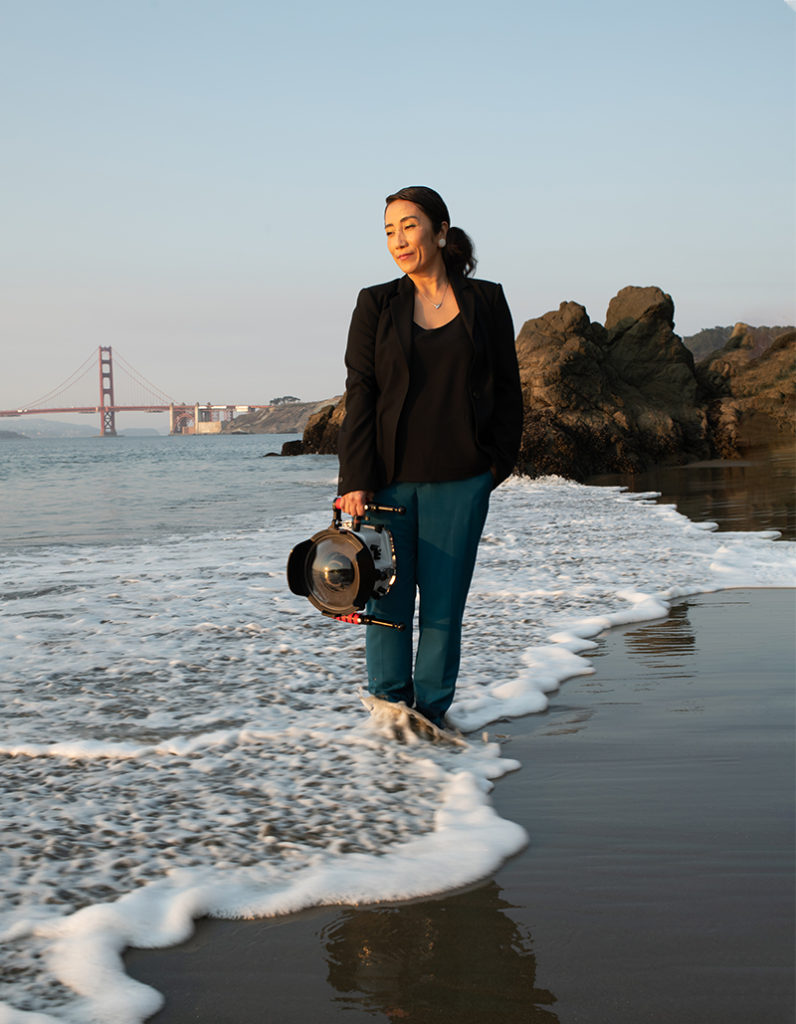
Erena Shimoda was born and raised in Tokyo, Japan. She received her Divemaster certificate in Venezuela in 2005, and began shooting underwater photographs in Thailand, Bonaire, Bahama, Corsica, Cozumel, Cancun, and Hawaii. She specializes in underwater portrait photography and uses her background in New Media and Fine Art to create unique compositions in different media.
She pioneered underwater transformative photography after surviving a car accident in which she lost her father and was severely injured. As a part of her healing process, she volunteered at the American Cancer Society’s Look Good Feel Better program. The program is for cancer patients to reassure there is beauty during and after cancer.
By combining total immersion with portrait photography, she discovered a powerful transformation that can help others who are traumatized by physical disabilities, domestic violence, and PTSD. The transformative effect of her portraits prompted Erena to use her experience in underwater photography to promote recovery, tranquility and freedom. She knows that the power of water combined with the creative process transforms body and mind.
She’s been a guest lecturer at Google, Apple stores, Scuba Diving show, City College of San Francisco Photography Department, and her underwater healing project has received widespread media attention, including coverage by NBC Bay Area, CBS News, USA Today, and the Huffington Post. Her work was also on display at a medical conference.
Podcast Transcript
Ep 29 – Erena Shimoda
Brett Stanley: [00:00:00] Welcome back to the underwater podcast. And this week we’re honoring breast cancer awareness month with underwater photographer Erena Shimoda. Erena works with cancer and trauma survivors to give them an experience like no other. And a way to help them heal emotionally through the therapeutic immersion.
Erena raised money to fund her work, donating almost half of it to charity and the rest of photograph 13 cancer survivors. We talk about her approach to this work and how her own trauma helps to guide others through this process.
Okay. Let’s dive in.
Erena. Welcome to on the water podcast.
Erena Shimoda: [00:00:34] Oh, thank you for having me. I’m really excited and nervous at the same time, but I’m, you know, I’m looking forward to just share my story.
Brett Stanley: [00:00:43] Yeah, it’s such an interesting story too. Um, I mean, you can, you can kind of flesh this out, but, but you work with, trauma survivors as well as, you know, people involving breast cancer and other forms of trauma, um, um, underwater with your photography, then talk us through that, how that works.
Erena Shimoda: [00:01:00] so I started working with, uh, survivors back in 2013. And before that I was, you know, I’m a scuba diver, so I was taking pictures of fish and Marine life. And that was like from like 2003. an incidence, I thought. Uh, traveling for like, you know, like a big amount of time because I have to work.
Uh, I started taking pictures of people instead of fish and from there, um, I realized that my clients are gaining their confidence and they’re really happy for, you know, What they see on the water and that there are beauty. Right? So when during that, I was also volunteering book, American cancer society’s look good, feel better.
It is the program for cancer survivors to feel good and beautiful about themselves by learning how to put makeup on during their chemo.
Brett Stanley: [00:02:01] Oh,
Erena Shimoda: [00:02:01] Um, Um, yeah. And also how to put, uh, Like the wig song because they lose their hair.
Brett Stanley: [00:02:07] Oh, right. So it’s, it’s a system where they’re like, uh, volunteers that kind of help them to go to the next stage of their recovery by looking and feeling better in themselves.
Erena Shimoda: [00:02:17] Right. So in that group, I’m there as a general volunteer. I just help them, you know, put the makeup and put the makeup kit and on the table and when they need help, because they’re really weak because they’re still on chemo. So I just help them out, whatever they need. And after the session I can see.
Their face has changed, you know, compared to the first time when they come in two hours before they’re really nervous or really tired from the medications. But after the class, after they gain their knowledge on how to put their makeup on to feel. Beautiful again, the FA you know, they’re all getting out of the class, smiling.
So when I compare that with my own client, they also go through the same thing. So, uh, 2013, if I needed to launch a campaign called underwater healer about faced to help cancer survivors rediscover the beauty through underwater. Portrait photography.
Yeah. So I went through that, uh, uh, using indiegogo.com.
It’s like a crowdfunding, uh, website. it was a heart. I didn’t realize what I was going in, putting myself into because I never done this before. Have you done, have you done the crowdfunding before?
Brett Stanley: [00:03:40] no, I haven’t. And to be honest, it looks, it looks really intense and kind of a little, uh, uh, a little scary, cause you’re putting yourself out there, right? Like you’ve really got to kind of campaign for yourself.
Erena Shimoda: [00:03:49] Right. And I was, it’s basically an organizing everything. So, um, It was a lot of work, but I committed myself to do this for the next, the 30, uh, 30 days to get donations, uh, that I’m going to help. I want to help like 13 survivors that I have on my list and to go through, to get to them, to do the underwater portrait session, I need this kind of money.
So that was, so that was the starting point of this journey with, uh, the project with survivors.
Brett Stanley: [00:04:21] And so how did the Indiegogo go? Did it, did it, was it a success?
Erena Shimoda: [00:04:25] Yeah, it was so hard. Uh, so I, my goal was, I think it was, my goal was 15 K at first, I didn’t know how much I needed to, to ask for, because. It depends on the locations I’m going, uh, the pool rental fees.
And so I just put 15 K and within 30 days, I was just, um, just asking, asking, asking all over and I find that it got to 10 K so, so what’s great is just that if I don’t reach that goal, Indiegogo takes, you know, um, It’s like a, a little penalty. So they take a little bit more percentage from the total.
Brett Stanley: [00:05:06] for using this service,
Erena Shimoda: [00:05:07] Yeah. I could choose if I want to take the money or not. And, but I still decided to take that the money I received so that I can reach out to, you know, Whoever. I mean, I tend the 13 people I’m really good at budgeting, uh, money. So I got to reach out to all of them.
Brett Stanley: [00:05:29] Oh, great. So that, that, so that 10 grand actually gave you a good enough start to be able to reach out to all of them and to do the project.
Erena Shimoda: [00:05:37] right. So it went down to like seven or eight. Okay. Cause the, uh, tax and also the penalty. Uh, so with that, the, you know, seven or 8,000, I got to reach out to 13 and also maybe more because, uh, some of the. The pool owners are generous. So they gave me free rental fees. Um, yeah. Or sometimes they let me stay at their apartment.
Uh, so I don’t have to pay for the hotel or I guess Airbnb at that time too. So yeah.
Brett Stanley: [00:06:11] w were you traveling a lot to, to do this project? Was it Fairfield? Cause you’re in, in San Francisco, right?
Erena Shimoda: [00:06:16] Yes. So I got to go to, LA um, Boston and Hawaii, but, but actually, so the, uh, you know, like I was old also combining with my vacation time, so I was, you know, donating my own money to
Brett Stanley: [00:06:35] Yeah. So you were doing these, these shoots while you’re on a, on a trip somewhere else. at the same time.
Erena Shimoda: [00:06:41] Right. Love to travel too. So I’m a traveler and I like to travel and then I get to meet people at the same time. So it’s a win-win.
Brett Stanley: [00:06:50] yeah, yeah, exactly.
Erena Shimoda: [00:06:51] Yeah,
Brett Stanley: [00:06:52] I mean, exactly the same way, you know, if you can travel and do your passion at the same time then.
Erena Shimoda: [00:06:56] yeah, yeah. We’re not
Brett Stanley: [00:06:59] And so, so how did you end up having a list of, of 13? Um, people to work with. Where did, where did they come from? Were they people that had sought you out at some point, or you had just met through your own, uh, your own work?
Erena Shimoda: [00:07:11] so the first 13 survivors are from like maybe I, I got to know few people from the Bay area and from them, they know some other people, so it’s just like a ward of the mouth. And then also I post it probably on my Facebook. Or, or Twitter. Um, then yeah, I got some response and because this is like the first, just 13, uh, almost okay.
2013. So it’s seven years ago. Nobody had done, I think maybe so not two, but nobody had done anything like this. So people were suspicious about me. That if I’m going to exploit the they’re in a personality or identity and which I’m not trying to do that, I was trying to, um, you know, work with them with this project.
Brett Stanley: [00:08:05] them. Yeah.
Erena Shimoda: [00:08:06] helped them. So I had a hard time to get trust first because I didn’t have any, um, portfolio of survivors back then. Yeah. But now.
Brett Stanley: [00:08:17] have the experience they were like, or I don’t know, like a year just using us to make images or are you using, or are you actually trying to help us
as a, as a community?
Erena Shimoda: [00:08:26] yeah. Yeah. So it was, uh, uh, so by building up the portfolio, the people started to trust me more and, uh, that I get more calls or emails that they’re interested in. Participating for this project.
Brett Stanley: [00:08:42] Right. So now you get a lot of, is it more word of mouth that you’re getting people for the project?
Erena Shimoda: [00:08:48] Yes. Uh, I think so from, uh, from the cancer survivors, friends of friends? Yes.
Yeah.
Brett Stanley: [00:08:54] they’re seeing their, their images and, and wanting to do that themselves.
Erena Shimoda: [00:08:58] Right. Especially on the Instagram or, uh, if, you know, if you tag, if they tagged my name or something like that. So I’m really grateful for, I mean, social media is kind of crazy now these days, but, um, it, yeah, I’m grateful that they can find my name.
Brett Stanley: [00:09:14] Oh, absolutely. Yeah. Uh, to sort of, to do the project as a, as a, an initial thought. What does taking cancer survivors underwater and photographing them?
Was there like a therapeutic kind of side to, to them just being in the water on its own? Or is it just about the photography?
Erena Shimoda: [00:09:31] right. Uh, Uh, for me, uh, for, for cancer survivors, they wanted to, they wanted to face their fears and try something new, you know, it’s, it is like the underwater portrait photography. You can not really practice at home. And it’s something that. It’s really special for them that they have, you know, they have been losing all their courage and their interests, or they feel isolated and they feel they are feeling lonely.
So by doing this thing, um, the new project, they are gaining their confidence and it’s like opening them their new doors to move on to their new life. So, yeah. So. They are scared to be in the water and excited at the same time.
Brett Stanley: [00:10:22] that’s great. How did they find it? What was their kind of response to the, to the session was there a, an initial period of them kind of freaking out and then slowly getting used to it? Or did they kind of take to it quite quickly?
Erena Shimoda: [00:10:33] Well, so most of them are new to underwater modeling and my clients are all like that too. So I’m getting used to work with people who are new to water, um, in the, by looking at the pictures, they think that it’s really easy. The next picture it looks like, ah, so beautiful. And then, and then they have this.
That imagination of how, what they want to do on the water. And so I asked them what they want to do, and sometimes it sounds like it’s going to take 30 minutes to be in the water so that they create, like, I want to do this and not so realistically, sometimes the first dip would be like two seconds. And so I just let them know so that they don’t freak out.
They don’t surprise themselves too much. And, and they, they get, I don’t want them to get upset. So, um, I,
Brett Stanley: [00:11:28] are different to the, to the experience.
Erena Shimoda: [00:11:31] yeah, um, um, it hurts, you know, it breaks my heart when they’re like, you know, when they’re going through the struggle, you know, the hard time, but I tell them everybody is going through the same thing. It’s not only that. Um, uh, so, you know, first five, 10 minutes, it’s like a practice. So, so I let them too. It’s, everybody’s, body’s different.
And I had to kind of calm themselves by doing like a breathing, breathing exercise, because when you’re, when you’re too nervous and scared, you’re breathing too fast. So that is the opposite effect. So I tell them to just move their arms slowly, just get used to the water and breathe in and out, like, you know, count of five.
So we do this together so that they’ll, you know, they’ll feel more, they don’t feel like they’re alone. Um, um, they feel. Little bit more comfortable after like five minutes. I know that you go through the same thing, but you work with models a lot, so I’m sure like you understand what I’m talking about.
Brett Stanley: [00:12:33] no, I do. And to be honest, 90% of the people I work with are not, are not models I work with with regular people. So I know exactly what you’re talking about, where you’ve got this, you’ve got at least, you know, 10 to 15 minutes of the session is just getting someone to a nice, comfortable place where they are.
Accepting of the water where they’re not fighting it, you know, where their, where their fear starts to drop away. And, uh, I don’t work with, or I haven’t really worked with, you know, trauma survivors. So I don’t have a lot of that experience, you know, with that extra added, I guess kind of layer of fear. So that must make things a little harder for you where you’ve got someone who has gone through some, some recent trauma and also is trying to get underwater at the same time.
Erena Shimoda: [00:13:17] Right. Like so many things that happening in their mind. Um, but by accepting this project, they’re already kind of ready to let go
and show them. Right. And then they have to feel, they just need to feel that they’re safe on the water. emotionally and physically. So I start from the shallow end first to just let them know that this is okay.
And I’ll be there for them.
Brett Stanley: [00:13:44] Yeah, that’s great. And then do you, is it just you and the client? Do you have other people there as well to kind of support them?
Erena Shimoda: [00:13:51] Yeah. Um, sometimes they come in by them because they want us to be alone. They want to have their meat, you know, me time, uh, because I want them to expect, yeah, they want to experience this, you know, by themselves. It’s like, if, especially if they have family and kids, they haven’t been alone for a long time.
So on the water, is there like a beautiful escape? Um, Yeah. And then sometimes they bring their friends or family, which is great for me too, because I asked them to be involved in this photo shoot so that it’s like a teamwork and a family work. Um, they can, they can also take, you know, BTS shots for, for themselves.
And then for me to, that’s a great support for my, my end too. Yeah.
Brett Stanley: [00:14:38] And so are you working primarily with, um, with people who have recovered from cancer or I guess they’re in remission or are you dealing with people who are going through chemo at the same time?
Erena Shimoda: [00:14:48] yeah, all of them. Uh, so as long as they’re they have the okay. Signs from the doctor, um, I’ll work with them even though they’re on chemo. Uh, um, they doing, if they’re still fighting. Yeah, but right now, because of COVID I want to be careful and I want them to be, yeah, I’m not, I’m sure they are also aware of it too.
So, uh, I’m being, working only with survivors now
Brett Stanley: [00:15:14] Just to limit any of the exposure and to limit any risk in terms of affecting their health.
Erena Shimoda: [00:15:19] Right. but yeah, I will. Yeah. I just, uh, I’m open to anybody who wants to challenge this, this session, because I know that it is going to change their, their lives.
Brett Stanley: [00:15:30] And that that’s the thing. I think you’ve got a similar story of, of the water changing your life due to trauma. I watched a, um, I think it was like a Google talk that you gave, and you were talking about your trauma as a, as a young child
Erena Shimoda: [00:15:45] all right.
Brett Stanley: [00:15:46] was kind of your, I guess your kind of like a safe place for you to go talk us through that.
Tell us what your trauma was like.
Erena Shimoda: [00:15:53] yeah. Um, Oh, first of all, thank you for watching the Google talk. Uh, it means a lot to me, so thank you for that.
Brett Stanley: [00:15:59] Yeah. No, it was great to get a better understanding of what your story was like.
Erena Shimoda: [00:16:04] Yeah. Thank you. Yeah. So, um, When I was, well, it was like, uh, when I was 22, I got into a car accident. So I’m originally from Japan and my family. And I moved to us when I was 14.
And then when I was 22, um, we got into. Major car accident in San Jose. We’re coming back from this family road trip from Arizona. We were only like 30 minutes away from my home. Uh, this is the one tire got, just blew up one tire blew up. So think the car just started rolling, but I was sleeping in the back of the van, so I don’t remember almost any of it.
Um, When I woke up, um, that I found that, that, Oh, I’m sorry. I’m just like,
Brett Stanley: [00:16:52] Would you rather not talk about this?
Erena Shimoda: [00:16:55] Oh, I don’t know why I started to get like a really emotional, but, um,
Brett Stanley: [00:16:58] We can change the subject if you’d like.
Erena Shimoda: [00:17:01] Oh no. I think it’s really important that I’m like talking about it about this. Okay. So, um, So I got into car accident and then, um, I lost my father and I also, I also lost my, my life. I was thrown out the car and sent to ICU by helicopter and I fractured my entire body. So it w it was really miracle that I survived.
From this accident. And, um, unfortunately I lost my father from it, but my family and friends taught me that, you know, like my father protected me and I’m a survivor for a reason. So, um, too, To make my father proud. I wanted to do something. Maybe I wanted to follow his path, which is to help people. He was donating money through like, it’s like a donation or the organization called, uh, tutoring international.
He’s been doing that since I was little. And then. And then when I was walking on the street, these kids were like asking for donations for that same company, so same organization. So I decided to sign up and helping out, you know, follow his path. And also I wanted to do more and, uh, to help other people.
That’s why I started, um, Th, uh, volunteering for American cancer society, then Saudi more people using my underwater skills. but going through that, I was still having some, um, issues, which is, uh, depression. I never got this depression in the past and I didn’t even know what it was because I was, I just could not get up on my room.
So. I didn’t want to see anyone. It was also affecting my job at that time. And I was seeking for help and which is, you know, I’m glad that I, you know, made myself to call the doctor and find it out. I went through, you know, The psychotherapist and psychiatric and psychiatrist and therapist, and everyone just, they just couldn’t figure out what it was, but they gave me the antidepressant and I was on the medication for over a year, but nothing was working for me and it was, I was feeling even worse.
So then I realized that, you know, when I discovered scuba diving, um, It just made me feel so light and lifted. Yeah. And, and since I cannot scuba dive in San Francisco, uh, I started swimming every day and when I was swimming, um, I just felt so good to start a day like in the morning. And yeah,
Brett Stanley: [00:19:43] were you swimming labs or was it just, just a recreational swim?
Erena Shimoda: [00:19:46] Ah, like a lapse. Yeah. So it’s, it’s kind of called swim in the ocean. I know some people do it, uh, but our ocean here it’s pretty dark and uh, uh, maybe like fifties.
Brett Stanley: [00:19:58] exactly. It’s not overly inviting there.
Erena Shimoda: [00:20:01] Yeah, and I had to wear wetsuits there. So, uh, to be free, I wanted to just swim in the warm, like a heated pool, um, at the gym it’s yeah. So it’s, it’s also therapeutic to be in the warm water. Uh, so I was swimming every day and then I realized that it was. Kind of a good way to be honest about myself. Um, I feel that water makes me honest and it makes everybody honest.
You can’t really lie on the water. And then one day I realized that why I was, you know, why was I having depressants? Because the dip, the medication was not working at all, but all of a sudden, you know, the swimming started to work. So. I dropped all my medications because of that.
And then just to rely on, rely on all the water and swimming every single day to swim since then. And now I’m off, you know, off medications for a long, like a years now.
Brett Stanley: [00:21:03] That’s amazing.
Erena Shimoda: [00:21:04] Yeah. It’s, I’m really happy that I found it. And also I’ll I also found out that because they make me made me honest. Um, the, the reason for having the depressor was I was just hiding my story, um, in my mind.
And I didn’t let anybody else to know that, um, Because the reason my father passed, I was blaming on myself and also I was having the survival guilt on that. Yes, I’ve already guilt on, not because, you know, I thought I killed him cause I could save him. And so, yeah. Um, I think for realizing that’s what it was and.
I could help him by driving instead of letting him drive the car, I could maybe survive and he could be, you know, we could be all happy, but that was, I still have it inside of me, but I just have to keep swimming or be in the water when that happens. When the, you know, when it triggers in my brain, I had to just go to the water.
So.
Brett Stanley: [00:22:11] Yeah, I think there’s something very therapeutic about the water on our skin. You know, we have this response once our faces is under the water. And once we, once we went our brain, I think changes too to accommodate that feeling. And I think as you say it, it, it makes you honest because it’s you and the water there is, there is no way to, kind of fool it, I guess.
Erena Shimoda: [00:22:33] Yeah.
Brett Stanley: [00:22:34] that kind of therapy of, It’s all very real and very rule. And by the swimming, the laps, you know, you’re, you’re using your energy and you’re using your power to kind of move through this amazing substance that, you know, that it, it has a therapeutic quality just inherently
Erena Shimoda: [00:22:50] Yeah, it’s also challenging too. If you are the, you know, swimming. Like swimming in the water. I just like, you’re like, if you did a freestyle, you’re just like going forward. And it just makes me feel move forward with my life too, by swimming forward
because
Brett Stanley: [00:23:07] The of being pushed through that water is I think is very freeing.
Erena Shimoda: [00:23:11] Yeah. And also the pressure when you go under water and it just makes me feel like the blanket, I have this like a underwater blanket on me, so it makes me feel comfortable. Yeah. Cause, cause I usually sleep on my bed with, I have like five different layer of blanket on me. So it’s heavy. It’s like a, what do you call it?
It’s like a heavy blanket.
Brett Stanley: [00:23:34] Oh, like a weighted blanket.
Erena Shimoda: [00:23:35] Yeah, I do have that on me. So it’s like that in the water
Brett Stanley: [00:23:40] yeah. I like to think that the water is hugging you,
that it is, it is, you know, providing a safe place for you. Um, and that that’s beautiful, that that has, has helped your own depression. That’s just, just by swimming through the water and using your energy in the water in that way as has helped you through your therapy, but also has kept you creative as well.
Erena Shimoda: [00:24:00] Yeah. And a may my brain clear too. And I think this is the healthier way to it’s like alternative medicine for, I
Brett Stanley: [00:24:10] Yeah.
Erena Shimoda: [00:24:10] cause I don’t want to believe that all the, you know, medicine’s going to work for everybody’s body. Um, and definitely it was not for me. So yeah.
Brett Stanley: [00:24:19] That’s perfect. So I think in your, in your Google talk as well, I think you talk about total immersion therapy. Um, I don’t know a lot about that, but I think what we’ve been talking about is, is part of that is using the water as, as a way of pushing through trauma, because you work with not just cancer survivors, you work with other trauma survivors as well, right?
Like PTSD and, and other things like that.
Erena Shimoda: [00:24:42] Right. So I also work with people who has been through, you know, like a sexual abuse, domestic violence, and also from the car accident, they get, they lose their body part of their body. And also veterans who has been through all the trauma through their yes services. So some of them, um, are familiar with scuba diving.
And so when they, they use that scuba diving as a recreational therapy, because when you, when they go underwater, um, there are chronic pain, PTSD, and Phantom pain. It goes away. So, yeah. So in the water also that. Uh, I’ve worked with a couple of people who is amputated. Uh, they feel, they don’t feel the pain
Brett Stanley: [00:25:32] Oh,
Erena Shimoda: [00:25:32] of the Phantom pain.
Yes. Uh, limb Phantom. Limb pain. Yes. So
Brett Stanley: [00:25:38] them feel whole again.
Erena Shimoda: [00:25:39] yeah, they don’t feel, I guess I never had that kind of pain before because I never lost anything, but they feel this like a pinch, like, uh, they feel like the needle is pinching their skin. Oh the nerve. So when they go in the water, I guess maybe the pressure of the water makes the pain go away.
Brett Stanley: [00:25:58] Oh, that’s great.
Erena Shimoda: [00:25:59] Yeah. So I see that in themselves and also they feel free on the water and they don’t, they realize that nobody is judging them when they go on the water. Yeah, cause they’re the only one and it’s their space and they feel safe. I think safe and trust is really important when we do the underwater photography.
Yeah. So I usually build the relationship before the photo shoot,
Brett Stanley: [00:26:28] And how do you do that?
Erena Shimoda: [00:26:30] So if you can meet in person, that is perfect. But, uh, now these days we do FaceTime. Yeah. FaceTime. Yeah. And I’m always available just like, um, anytime they have questions or concerns, um, so they can reach out to me so that we, you know, the FaceTime works really well.
Um, because it helps me to see who they are, what they look like. I usually read their body language. Um, yeah, cause a body language. I’m used to read that when I came to U S I was 14. I couldn’t speak English at all. I didn’t, yeah. I couldn’t speak anything. So I didn’t know what they were saying, but. I have to guess everything from their face, her expression and body language. Yeah. So it’s from that. I am get, I, I think I got used to kind of getting good at what they are talking about or what they are feeling at that time.
Brett Stanley: [00:27:27] Yeah, just through their body language and
Erena Shimoda: [00:27:29] Yeah. Cause under water, we can’t talk, but then I can see their facial expression or body language if they’re experiencing the difficulties, if they want to try something too much or, um, they’re, if they’re really shy, you know, sometimes people, when they’re outside of the pool, they’re not shy, but they’re in the water.
Uh, you know, you. You know makes you honest. Right. So I can see that they’re actually a shy person or yeah.
Brett Stanley: [00:27:58] So their, their personality changes once they hit the water.
Erena Shimoda: [00:28:00] Yeah. The truth comes out.
Brett Stanley: [00:28:04] they might be putting a brave face on, on the, on the side of the pool. And then when they get in the water, it kind of washes that away.
Erena Shimoda: [00:28:10] Right. And then I’m okay with, I love to see the change of transformation because I want to see their truth. I’m not really looking for any fake, you know, poses. So fake of themselves, I’m more into just looking at who they really are. So that is the, the transformation that they’re going through and they’re just letting go of their past or letting go of whatever they have on their shoulder.
So when they come out from the water, the shoulders are light, you know, they are lifted and they’re relaxed and happy.
Brett Stanley: [00:28:45] That’s definitely something that I find in my work as well. Is that. There is a transformation from that, you know, that first time going under the water where there’s some, probably some fear and some apprehension to when they come out after like a successful shoot. And they’re just so in energized from that experience, it’s not even about the photo so much.
It’s about the, the experience that they’ve had kind of meeting themselves underwater and accepting it.
Erena Shimoda: [00:29:11] Yeah. Accepting and let go. And like, um, it’s there. It’s because I’m, I want them to think that this is their project, even though they asked me to direct them. I, I usually don’t because I tell them, Hey, you know, I’ll be there to help you, but everybody’s, body’s different, especially underwater, like, um, so I just see what they can do, what they’re comfortable with and then I help them out from there.
Brett Stanley: [00:29:36] Yeah. So you’re like a guide rather than a director.
Erena Shimoda: [00:29:39] Right, right.
Brett Stanley: [00:29:40] And that’s beautiful that you taking them through this process that is helping them to, you know, push through whatever it is that life has thrown at them
and giving them a beautiful image of that experience.
Erena Shimoda: [00:29:53] Yeah. It’s also helping them to going through my own by helping others. Um, so when they, when I see their smiles, you know, when I, when I show them the preview images from my camera, you know, I see them smiling and like, yes, it’s my goal. It was my goal to make them smile. So I’m like, I’ll be really happy or sometimes, uh, they can, they they’re, they’re usually hard on themselves.
So, I tell them, you know, to encourage them to be free more. I relaxed, I don’t want them to feel too stressed out, so,
Brett Stanley: [00:30:28] the pressure off them and
yeah. Create a beautiful space for them to relax
Erena Shimoda: [00:30:32] Yeah.
Brett Stanley: [00:30:33] And, and so with, uh, with these kinds of therapies and stuff, is there, is there anyone who hasn’t been able to successfully
complete
Erena Shimoda: [00:30:43] I know it’s a heartbreaking part. I’s want to say everybody went through. Uh, at the, uh, uh, everybody had like good experience. I hope. Um, but I know that one person that I still think of her, uh, she was a breast cancer survivor. It’s uh, one of my first 13 survivors from the campaign. She was the only person who didn’t want to do FaceTime.
And I was a bit worried about it. And. But I just have to just meet her for the first time at the pool. I think she was hard on herself and then maybe I tried too much. So I think that is why doing a FaceTime is really important. And also I want them to listen that, you know, You know what I suggest or, yeah.
So I was, I was sad when she was not really happy. I’m like, Oh no.
Brett Stanley: [00:31:38] And that is hard though. Cause I mean, you’re dealing with so many different personalities and so many different life stories that it’s hard to always be successful to, or to make a connection with someone or, you know, like if, if someone has a certain. Personality.
It’s hard to know every time which techniques are going to get you to the, to the right spot.
Erena Shimoda: [00:32:00] Right. It’s hard. Um, it’s like every time, you know, it’s a, it’s a big challenge.
Yeah.
Brett Stanley: [00:32:07] that’s what I find as well is that it’s it’s, every client is different and every client is a new kind of puzzle to work out. Some of them are very easy and you can use the same techniques every time. Whereas others require a different way of thinking. And personally, I love that challenge of, of trying to work out how to get someone to that.
comfortable place.
Erena Shimoda: [00:32:28] Right. It’s a, I love it too.
Brett Stanley: [00:32:31] I think that, that from my experience, the best photographers are the ones who have a lot of empathy because they can put themselves in the shoes of their clients. know, like they can kind of change their approach to stuff because they can can in a way feel what they’re feeling. Whereas if the, if someone doesn’t have a lot of empathy, it’s hard to, to change your approach.
Erena Shimoda: [00:32:55] Right. You had to kinda know what, other people are going through. And I think definitely it’s, uh, you know, I’m glad that I have experienced in the past and also me. You know, coming to us, I was, I was really alone from that speaking English. So I understand what others are going through.
If they’re going through the similar situation, if they’re alone or if they’re struggling with something I can, you know, I’ll be there to help them because I need it because I needed help when I was a kid.
Brett Stanley: [00:33:27] So.
you can draw on those experiences to, to, to guide them through these situations.
Erena Shimoda: [00:33:33] Yeah, I understand their feelings for sure. Yeah.
Brett Stanley: [00:33:37] Uh, what’s next for you? Have you got projects coming up that you’re, that you’re excited about?
Erena Shimoda: [00:33:43] Oh, so this year is pretty, uh, interesting year. So, um, um, um, um, right. always in the Bay area, it’s hard to find a pool. And right now I was using this pool in, you know, in Pacifica and they’re having hard time with the COVID. Um, now I found this app called swim plea. Have you seen, have you heard of it?
Brett Stanley: [00:34:07] I was like the Airbnb for swimming pools.
Erena Shimoda: [00:34:10] Yeah, so I started to use that and because they were available during this COVID, um, and which is good for me, uh, cause I can go at any time, um, when I get the day off. So I’m gonna try to do that until the summer ends. And then see if we’re available to travel again this year, or maybe early next year, I would love to, you know, go to different places and meet other survivors.
Yeah.
Brett Stanley: [00:34:40] And so how can people find you if they are going through. Um, some sort of therapy or some sort of trauma and would love to work with you,
Erena Shimoda: [00:34:47] yeah,
they can, you know, they can email me or they can look up my name, uh, on the website.
Brett Stanley: [00:34:54] Yep. So if they Yep. So if they just Google every, no, Shimoda.
Erena Shimoda: [00:34:57] Yeah, I readiness Shimoda or I also go a website, a underwater healer.com. You can also type on the water transformation and it will come out.
Brett Stanley: [00:35:08] that’s perfect. Marina. Thank you so much. This has been really interesting as it’s a side of things that I’d never really experienced before. So, so thank you for sharing that with everyone.
Erena Shimoda: [00:35:19] Oh, thank you so much for having me and, you know, just, I feel really happy to talk to you finally,
Brett Stanley: [00:35:26] Yeah. Yeah, absolutely. Thanks, Irena.
Erena Shimoda: [00:35:28] Thank you so much.

